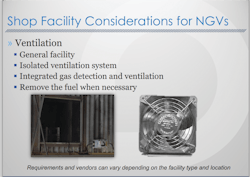More transit agencies across the U.S. and Canada are turning to natural gas to power bus fleets in an effort to reduce operating costs while implementing green initiatives.
But before turning to natural gas, industry leaders warn potential convertors to do their research first so they can safely and effectively implement the new fueling system and maintenance requirements in the shop.
“Like any project, you need to develop a plan,” said Konrad Komuniecki, senior director of operations for Westport.
Komuniecki said during an Aug. 8 webinar on natural gas vehicles that when converting to natural gas, it’s important to consider what type of training and tools will be needed for the conversion. Liquid natural gas (LNG) is stored cryogenically while compressed natural gas (CNG) is kept under high pressure, so it creates different needs depending on the form a fleet would use.
LNG is odorless and therefore Komuniecki said it’s crucial anyone using them make sure proper ventilation and alarms are put in place in maintenance facilities to warn of methane leaks. Some shops have bay doors worked into the gas sensors so if tripped, the doors will open in order to let gas out.
CNG does have odor in it, but Komuniecki said the gas sensors are still a good idea to have. Because of the combustible nature of both forms of natural gas, he also recommended managers do a full assessment of their facilities in order to remove any potential items that could spark an explosion, such as electric heaters, sources of electric arcing and lights, which can be replaced with specialized equipment.
Caution also needs to be taken when working on LNG vehicles indoors, because the fuel can begin to boil and escape while inside, which is also why it’s not advised to store units inside.
“As a general rule, we don’t recommend parking natural gas vehicles indoors,” Komuniecki said.
In warmer areas of the U.S., Komuniecki said some who invest in natural gas units will build outdoor facilities for technicians to work on them in order to mitigate some safety concerns, which also means less of an infrastructure cost.
“I think there’s a cost difference. In cold climates you need to worry about insulation and heating shop spaces via forced air or open flame heaters,” he said. “But in warm climates, you’re not worried so much about heat as mainly AC.”
In addition to new safety precautions, Komuniecki said technicians also need additional training in order to work on natural gas units and new tools, which can take up to three days to complete. Technicians and agencies also need to know the difference between using parts for natural gas units as opposed to diesel units.
Spark plugs or rings may look similar between fueling systems, but those not designed specifically for natural gas engines won’t work if installed. “This is very critical,” he said.
Technicians must also learn about when to defuel a natural gas vehicle for safety issues before performing service, Komuniecki said, and to check for leaks in the fueling lines before taking units indoors.
There are no national standards set forth in preparing facilities and staff for natural gas vehicles, Komuniecki said standards set forth by the National Fire Protection Association (NFPA), Canadian Standards Association (CSA) and Society of Automotive Engineers (SAE) all have standards to use as guides.
And before opting for natural gas, he said to contact a local fire marshal or authority to find what local standards are in place for natural gas facilities. Also check with local emergency officials to make sure they’re properly trained in natural gas issues so they can assist in event of an emergency, especially in rural areas.


